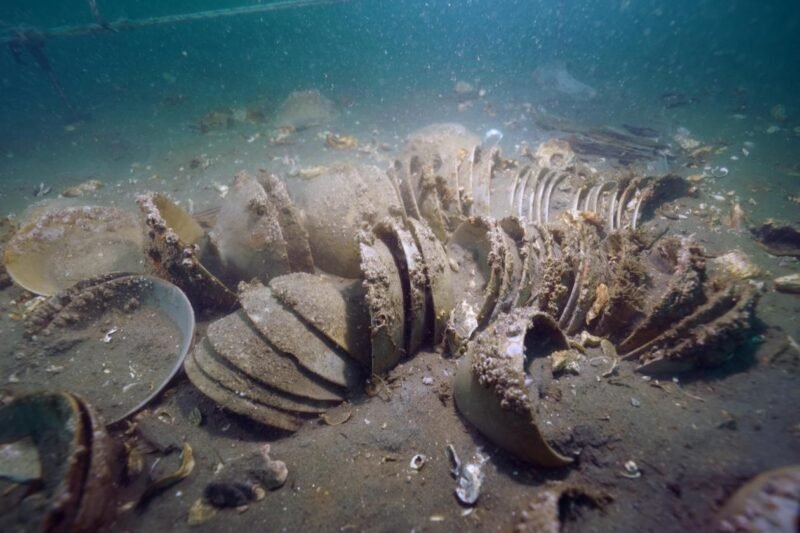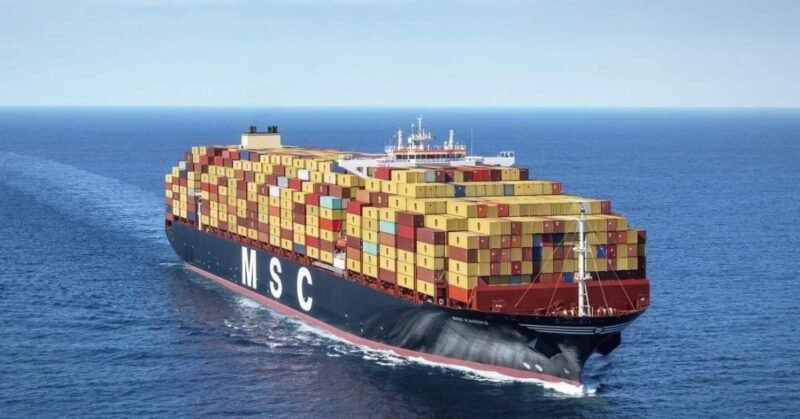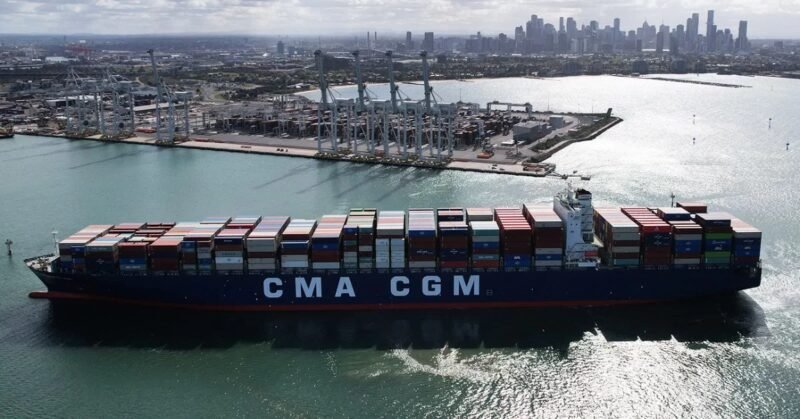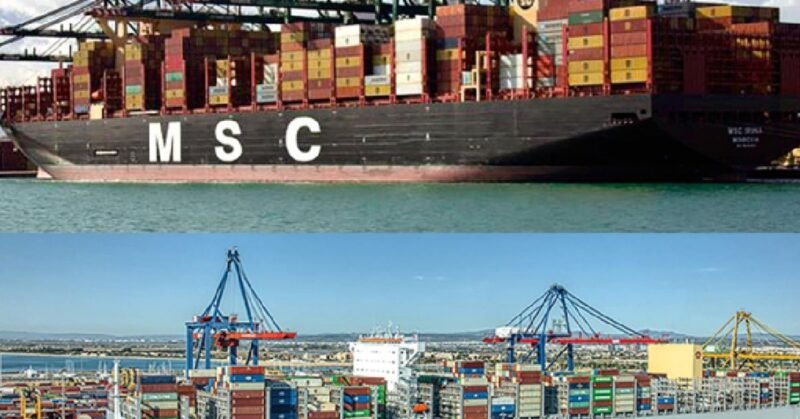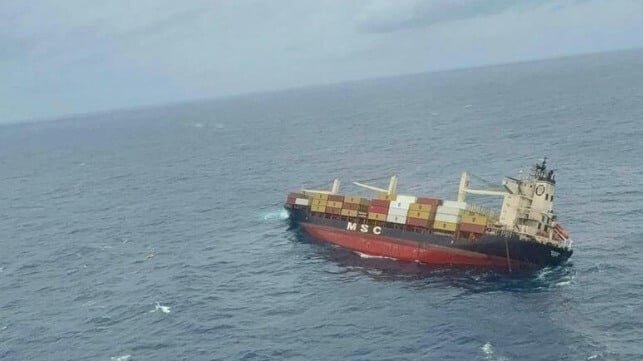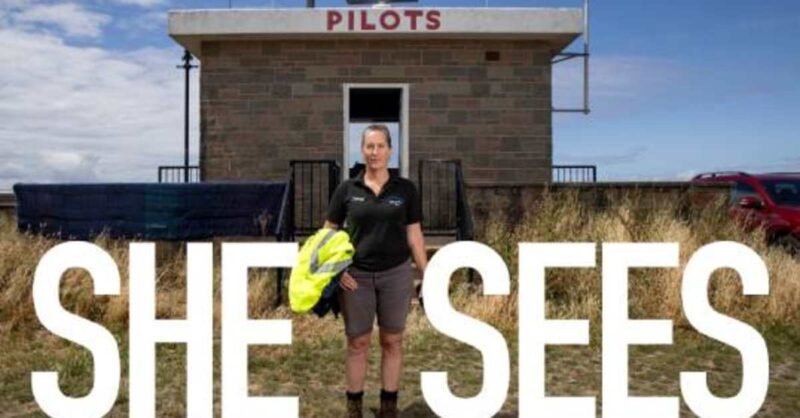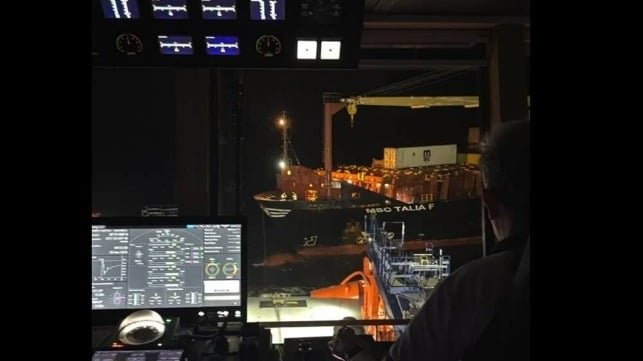Following Stories compiled in this News Digest for the week from 05 Sep 2022 to 11 Sep 2022 in descending order:
- India: National Maritime Heritage Complex to be built at Lothal in Gujrat
- A Forgotten Page of Indian Maritime History
- SpaceX’s high-speed internet service is heading to sea
- Inmarsat launches Fleet Safety solution
- MSC Alters Course Around Sri Lanka To Safeguard Blue Whales
- Shipping mourns Queen Elizabeth II as Britain’s longest-serving monarch dies at 96
- Designs Progress for Zero-Emission Cruise Ship
- MSC to implement Anti-Roll Assist tech to safeguard containers
- Shipping can no longer remain on the sidelines, says ICS
- How artificial intelligence is steering shipping in the 21st century
- World’s fastest electric boat smashes speed record to hit 109 mph
- New Dual-Fuel Engine Launched at SMM
- Vessel Becomes Unique Lab and Demonstrator for New Technologies
- RWO launches new oily water separator
- Marine Consultancy Warns Ship Managers to Remain Covid Aware
- How Warlike Operations Area agreements protect seafarers
- India: Mission launched to trace lost port of Korkai
- Allianz Warns Number of Fires at Sea Increased Significantly
- A wider perspective on marine pollution
India: National Maritime Heritage Complex to be built at Lothal in Gujrat
11 Sep 2022
Ministry of Ports, Shipping and Waterways plans to build a National Maritime Heritage Complex (NMHC) at the site of the Indus Valley civilisation in Lothal, Gujarat.

A first of its kind complex in India, this centre will showcase India’s rich and diverse maritime heritage. The foundation stone for the NMHC project was laid by Prime Minister Narendra Modi and the consent for the master plan was given in March 2019.
The project is planned to be completed in different phases. In phase 1A, a museum will be built with 5 galleries and a naval gallery on 35 acres of land at an investment of ₹774.23 crore. In the phase 1B, remaining portions of the museum will be built, including galleries, light house, 5D dome theatre, Bagicha Complex and other infrastructure. This phase is proposed to be developed under EPC mode.
The Gujarat government is playing a vital role in this project. It is supporting the project by developing external infrastructure namely; by 4 laning of 11.58 km of road from SH1 to NMHC site via Gundi-Lothal-Saragwala village, by providing water supply connection to the site and by giving 66 kV power supply at NMHC. Reference
A Forgotten Page of Indian Maritime History
11 Sep 2022
‘From the Vedic period to the Gupta period and the Maurya period, India’s maritime power was well known all over the world. Chhatrapati Veer Shivaji Maharaj had built such a navy with this sea power that it would scare the enemies,’ Modi asserted, adding in relation to the new ensign for the Navy: ‘I dedicate this new flag to the father of the navy, Chhatrapati Veer Shivaji Maharaj.’

This genealogical halo is generous praise for the Maratha warrior-king who occupies a special niche in India’s medieval history. While experts may differ whether Maratha naval capabilities were more coastal than oceanic — an admiral in the Maratha navy, Kanhoji Angre (1669-1729), was a doughty sea-warrior and his small vessels were perhaps the earliest instance of the use of swarm tactics at sea to ward off a more powerful adversary – in this case, the Portuguese. In a rare tribute for its time, an early 20th century British historian, CA Kinkaid, describes Angre as being ‘Victorious alike over the English, the Dutch and the Portuguese, he sailed the Arabian Sea in triumph.’
The Maratha chapter of history has been nurtured by the Navy by way of naming a major shore establishment in Mumbai as INS Angre and INS Shivaji in Lonavla, the premier engineering training base.
During the same period, there was a kingdom in Kerala — that of the Zamorins — which invested in naval power. They enlisted the Marakkars who trace their ancestry to Egypt to provide the naval muscle to protect Zamorin interests at sea and were remarkably successful. As Admiral Arun Prakash, former Naval Chief, points out: ‘By waging a campaign against Portuguese dominance at sea for nearly a century, the Zamorins and Marakkars played a sterling role in keeping them off balance, and forcing them to move north into Goa.’ The Navy has a shore establishment named INS Kunjali (after the last Marakkar admiral) in Mumbai.
Modi’s reference to the Maurya period is pertinent. There is considerable evidence of trade between the Mauryan empire (325-180 BC) with distant Rome. Historian Pliny refers to the coffers of imperial Rome being emptied by the increasing import of silk and spices from the subcontinent. Much of this has been documented by historians.
Another dynasty is that of the Andhra-Satavahanas (circa 200 BC-180 AD). Their maritime reach was impressive for its time. But regrettably, we do not have accurate historical records of their naval battles.
In the first millennium AD, the Chola empire (circa 900-1200) expanded its reach from modern Tamil Nadu-Karnataka to Southeast Asia and some Indian Ocean islands, and had an ocean-going navy to protect its trade and expand the empire. At one point, the Bay of Bengal was referred to as a Chola lake.
India has chosen the Shivaji-Angre chapter to be prioritised in its maritime history. The history-heritage transmutation is complex and dominant political compulsions shape an objective recall of historical episodes and rigorous research. Whether Satavahana, Chola or Maratha, each of these long-neglected periods in Indian history needs to be rediscovered. Reference
SpaceX’s high-speed internet service is heading to sea
10 Sep 2022
Royal Caribbean Group is adding SpaceX’s Starlink Maritime to all of its cruise ships starting next year — a major win for the nascent internet service.
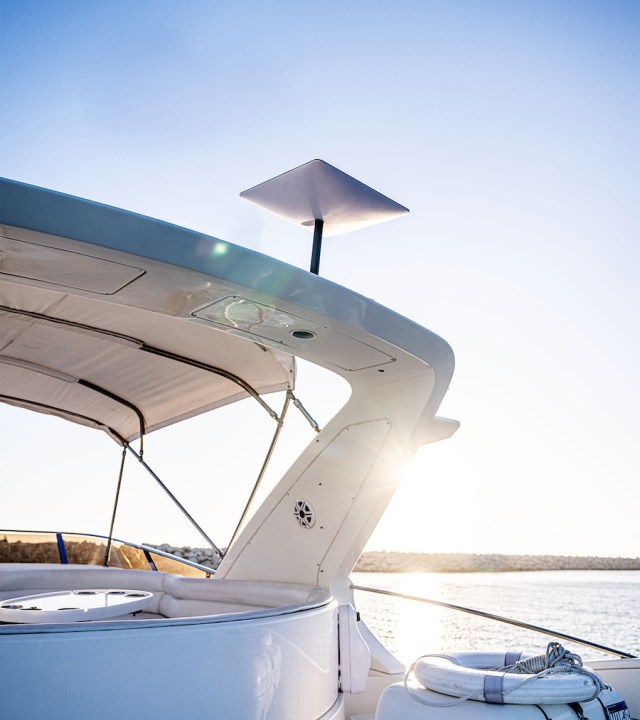
The challenge: While most cruise passengers aren’t likely to be glued to their screens while at sea, having reliable internet access is still important — passengers might need to check in with work or be reachable by the babysitter in places without cell service.
While internet access is available on all major cruise ships, it’s usually delivered via satellites. This service can be slow, and if the cruise ship doesn’t have a direct line of sight to a satellite, the internet might not be available at all.
Starlink Maritime: SpaceX’s Starlink is a relative newcomer to the satellite internet industry, but it’s already outperforming competitors, and the addition of more satellites to its mega constellation in 2023 is expected to expand its coverage to the entire globe.
In June 2022, the FCC approved SpaceX’s request to provide its Starlink internet to moving vehicles, such as trucks, airplanes, and ships. Within days, the company announced Starlink Maritime, a low-latency, high-speed internet service for vessels at sea.
The service costs $5,000 a month, plus a one-time fee of $10,000 for the installation of two “high performance” Starlink Maritime terminals that CEO Elon Musk tweeted are “ruggedized for relentless salt spray & extreme winds & storms in deep ocean.”
Currently, the service is only available near coastlines — mostly of North American, European, and Australian nations — but SpaceX plans to expand its Starlink Maritime coverage into the mid-ocean later in 2022 and in early 2023. Reference
Inmarsat launches Fleet Safety solution
10 Sep 2022
Inmarsat has launched its new Fleet Safety solution for maritime safety communication, following the successful conclusion of sea trials.

Fleet Safety was granted International Maritime Organization approval under Global Maritime Distress and Safety System (GMDSS) requirements following the assessment by the International Mobile Satellite Organisation (IMSO).
Inmarsat has updated documentation and created training material to allow members of the industry to prepare for the new safety service. It has also added Fleet Poll, a new data reporting service for long range identification tracking, vessel monitoring systems and asset tracking, as well as ships security alert system. The next stage for the company is to gain flag state approval for adoption across the maritime industry.
The new system will replace Inmarsat’s existing solution, Inmarsat C.
Fleet Safety will be delivered via existing FleetBroadband or Fleet One voice and data services with the addition of a maritime safety terminal. Its new interface is designed to enable seafarers to access critical functions and communicate with a network of over 60 global maritime rescue coordination centres (MRCCs) in an emergency within seconds.
The solution also includes a new Maritime Safety Information (MSI) interface which will allow users to control the stream of MSI broadcasts and download historic broadcasts, which include meteorological, navigational, and search-and-rescue warnings. A distress chat function will enable the creation of chat rooms between ships in distress, assisting vessels and MRCCs for quicker response times. Reference
MSC Alters Course Around Sri Lanka To Safeguard Blue Whales
10 Sep 2022
MSC Mediterranean Shipping Company has taken a big step forward to protect blue whales and other cetaceans inhabiting the waters off the coast of Sri Lanka by making modifications to the navigation guidance in line with top scientists’ advice as other vital actors associated with the maritime sector.

MSC, a global leader in container shipping and logistics, started in the middle of 2022 to voluntarily re-route vessels sailing by Sri Lanka on a new course nearly 15 nm to the south of the present traffic separation scheme, better known as the TSS, for commercial shipping.
Westbound ship traffic is now limited to a latitude between 05 30N and 05 35N. On the other hand, eastbound traffic is determined to play between 05 24N and 05 29N to avoid the designated cetacean habitats.
Besides, an exception was recently put in place for vessels that embark and disembark for safety issues in Galle, including in case of poor weather. Additionally, smaller feeder vessels that sail in the Bay of Bengal are recommended to reduce their speed to less than 10 knots in the area.
The area off its southern coast is one of the busiest and most important shipping channels in the world. It is inhabited by large populations of cetaceans, indicating that these could also be at risk of colliding with huge ships.
Simulations have reflected that shifting the official shipping lane by about 15 nm to the south may reduce the strike risks to blue whales by almost 95%.
But, despite years of advocacy by scientists, NGOs, and the maritime industry, the boundaries of the official shipping channel haven’t yet been reassigned to lower the risks of ship strikes on these cetaceans. Reference
Shipping mourns Queen Elizabeth II as Britain’s longest-serving monarch dies at 96
09 Sep 2022
Shipping is taking to social media to mourn the death of Queen Elizabeth II.
The UK’s longest-reigning monarch died peacefully on Thursday at the age of 96 at Balmoral in Scotland, according to an announcement by the royal family.
Bud Darr, the Geneva-based head of maritime policy, government affairs and shipping at container and cruise shipping giant MSC Group, posted to LinkedIn to express condolences to friends and colleagues in the UK and throughout the Commonwealth of countries where the Queen was head of state.
British groups that serve seafarers were quick to honour the Queen, pointing to her support for those who work at sea.
The Mission to Seafarers posted a photo of its flag at half-mast in honour of her 70 years of “exemplary service” to the nation.
Gina Panayiotou, environmental, social and governance manager at insurer West of England P&I Club, praised the Queen as a “remarkable” woman leader.
The UK & Ireland branch of the Cruise Lines International Association said it is deeply saddened by the Queen’s death.
Konstantina Eleni Athanasiou, founder of London-based manager Prime Shipping, took to Facebook to mourn the Queen’s death. Reference
Designs Progress for Zero-Emission Cruise Ship
09 Sep 2022
Efforts are progressing to design and build the world’s first zero-emission cruise ship that will be outfitted with batteries and hydrogen fuel cells for its power. Norwegian start-up Northern Xplorer reports that it has selected a shipyard and is working with technology partners to choose the technologies for its first cruise ship. The company said it expects delivery of the ship at the start of the 2025/2026 cruise season.

Northern Xplorer and Portuguese shipyard West Sea signed a letter of intent for the construction of the cruise ship. West Sea said it intends to build the 250-passenger cruise ship at its yard in Viana do Costello north of Porto. The yard is currently involved in the construction of seven 10,000 gross ton exploration cruise ships being built by a Portuguese entrepreneur and marketed by Atlas Ocean Voyages.
The vessel’s design features ABB’s fully electric propulsion system, including the battery and hydrogen fuel cell technology that will enable it to sail emissions-free. Northern Xplorer reports that along with ABB they are currently in dialogue with multiple sub-suppliers for vessel systems. When the company initially announced its concept in December 2021, it reported that its current plan is for a series of 14 ships accommodating up to 300 passengers in 150 cabins supported by approximately 100 crew.
Northern Xplorer called the LOI “an important step toward creating a new paradigm in the cruise industry.” Sandvik previously commissioned the hybrid-electric sightseeing vessels Vision of the Fjords (built 2016) and Future of the Fjords (built 2018) in his former role as founder and CEO of tourism company The Fjords. Reference
MSC to implement Anti-Roll Assist tech to safeguard containers
09 Sep 2022
MSC Mediterranean Shipping Company (MSC) has signed a contract to implement the new DNV Anti-Roll Assist system and ARCS (Anti-Roll for Containerships) class notation on some 100 vessels, the first global liner company to install the application.

Anti-Roll Assist helps vessel captains to recognise and avoid the risk of parametric and synchronous resonant rolling, using a ship-specific hydrodynamic database to provide a risk picture based on heading, speed, loading condition, and environmental conditions.
MSC will be the first ship owner to implement the ARCS notation and will integrate the application with its onboard weather routing systems. The contract covers dozens of newbuildings, ships in operation, and vessels to be constructed, in a range of sizes. Reference
Shipping can no longer remain on the sidelines, says ICS
08 Sep 2022
The shipping industry must co-operate with other sectors to influence decisions that will fundamentally affect shipping, according to ICS.

In his keynote address at the opening of SMM 2022, ICS Secretary General Guy Platten said that shipping uses around 4% of global oil production and will need to look outside of itself during the transition to zero carbon.
Supplying shipping with renewable fuels would take around 100% of current global renewable energy capacity, and providing zero carbon fuels for the world will take an 18-fold increase in renewable energy, said Platten, a huge undertaking.
Platten repeated warnings on the availability of seafarers, and on the need to train crews to use the types of new technology on display at SMM and handle future fuels both to power vessels and as cargo.
The secretary general’s three takeaways from his speech were: 1> We must not underestimate the importance of people in any new technological developments. 2.> Shipping is not on its own. We must not work in silos. 3> Remember that the supply chain is interconnected. Reference
How artificial intelligence is steering shipping in the 21st century
08 Sep 2022
As the shipping industry increasingly adopts technology to stay on the move, North P&I Club reveals how it is using artificial intelligence to support key operations.

Artificial intelligence (AI) is fast gaining traction in shipping, with tools targeting regulatory compliance and cost reduction already well established.
While safety solutions have been slower to take off, their value is quickly becoming evident. With more and more shipowners recognising the potential of artificial intelligence to enhance their operations, the technology is gaining widespread acceptance throughout the maritime sector.
In marine insurance, too, AI is proving to be of significant value. North P&I Club currently deploys two AI tools to support its loss-prevention and risk-assessment services.
In the wider maritime community, shipowners are showing a clear preference for systems that support regulatory compliance and reduce costs. Accordingly, the main growth area for AI in shipping is voyage optimisation – the process of working out the best routes for vessels to carry out their tasks. Specialist voyage optimisation tools work to analyse the most efficient routes for vessels to take at sea.
Another important maritime application for AI is condition monitoring, which is looking at the state of various components on a vessel and analysing which of them need servicing, upgrading or replacing. This sees data from onboard sensors fed through machine learning programs to determine the best time to perform equipment maintenance. Depending on condition, the system might recommend delaying replacement, saving the owner money on planned maintenance.
Safety-focused AI solutions are popular in sectors where safety is a competitive issue, like the tanker segment, and among more forward-thinking companies with well-defined environmental, social and governance (ESG) strategies. As time goes on, and the bottom-line benefits of adopting such systems become more apparent, it is likely these systems will be used even more widely. Reference
World’s fastest electric boat smashes speed record to hit 109 mph
08 Sep 2022
Vision Marine Technologies, a manufacturer of electric recreational marine propulsion for OEMs, has announced that it broke the 100 mph speed barrier on an electric watercraft, a historic milestone in the boating industry. Several renowned players from around the world needed to come together to achieve such a feat.

Vision Marine, in partnership with Hellkat Powerboats, developed the V32, a 32-inch catamaran hull specifically designed to accommodate the necessary battery banks to power a pair of Vision Marine’s flagship E-Motion electric outboards with the sole intention of breaking new ground. The V32 was entirely designed from the ground up by Vision Marine’s internal engineering team and Shaun Torrente of Shaun Torrente Racing (STR), who was also in charge of rigging, setting up, and testing the V32 in Florida throughout the course of several months.
The electric watercraft is powered by a uniquely designed battery pack developed by Vision Marine in partnership with Octillion Power Systems. Moreover, Nextfour Solutions supplemented the vessel’s monitoring systems, and Pat Weissman of Weissman Marine engineered the outdrives.
On August 28, 2022, Shaun Torrente, a five-time UIM champion and current F1 H20 World champion, took the V32 to the water. He reached a new world record speed of 109 mph (175 km/h). It has surpassed the previous speed record for an electric boat of 88.6 mph (142.5 km/h), set by Jaguar on its lightweight Vector V20E in 2018. Reference
New Dual-Fuel Engine Launched at SMM
08 Sep 2022
MAN Energy Solutions has announced the launch of its MAN 49/60DF engine type at the SMM trade fair in Hamburg. The latest addition to its four-stroke engine portfolio, the dual-fuel engine is capable of running on LNG, diesel and HFO as well as a number of more sustainable fuels including biofuel blends and synthetic natural gas. MAN Energy Solutions states that it sets a benchmark in terms of fuel efficiency within four-stroke engines – both in gas and diesel modes – and therefore minimises fuel costs.

The 49/60DF is already available for order and is based on the new 49/60 engine platform that features MAN’s latest technologies, including two-stage turbocharging, second-generation common-rail fuel injection, SaCoS5000 automation system and MAN’s next generation Adaptive Combustion Control ACC 2.0 that automatically sets combustion to optimum levels. The engine also retains existing MAN technolgies such as the gas-injection system, pilot-fuel-oil system and MAN SCR (Selective Catalytic Reduction) system.
The 49/60 can start in gas mode where it complies with IMO Tier III without secondary measures. In diesel mode, it complies with Tier III combined with MAN’s SCR system.
Soot emissions are halved in diesel mode due to MAN’s new common rail system 2.2, while the 49/60DF’s methane emissions also drastically reduced in gas mode compared to its predecessor. The engine’s benchmark efficiency and fuel-flexible design offers multiple paths to emission compliancy leading up to 2050, as per the current Fuel EU draft. Reference
Vessel Becomes Unique Lab and Demonstrator for New Technologies
07 Sep 2022
One of the challenges for shipowners and operators in deciding on new technologies is often that they needed to be ordered without experiencing how they perform in real-life environments. Wärtsilä Voyage, part of the technology group Wärtsilä, unveiled at SMM in Hamburg a unique new solution, a demonstrator and innovation vessel that presents a platform to experience different technologies.

The 79-foot-long vessel named Ahti started her life as a German Government fishery patroller. She was chosen as a target for retrofit technology installations to prove what is already technologically possible for the current fleet, and to create a platform for further innovation and development. According to the company, she will profit a platform for trials that will be conducted in changeable real-life sea conditions which can be difficult and costly to recreate in a laboratory environment.
The creation of a floating R&D facility also helps Wärtsilä Voyage to cut down the cost and time barriers associated with real-life tests, returning meaningful results on a much lower risk and cost base than going into full-scale testing directly. Ahti also creates a first-party resource where customers and technology partners can collaborate. She will host partner technologies as well as those developed by Wärtsilä.
In the first half of 2022, Ahti’s bridge was upgraded with several products from Wärtsilä Voyage’s portfolio. Reference
RWO launches new oily water separator
07 Sep 2022
RWO has launched its latest oily water separator (OWS) designed for very large vessels.

The OWS-PT unveiled at SMM 2022 in Hamburg uses a “pressure type” system designed specifically for larger vessels such as VLCCs and VLOCs.
RWO Managing Director, Stratos Papamichalis, said: “Reliable and efficient OWS performance is increasingly important in ensuring effluent standards are met, but operational expenditure (OPEX) on OWS remains a concern for owners – especially where larger ships are involved.
The OWS-PT eliminates the need to install an additional feed pump and offers greater flexibility for installation as it does not need to be located beside the bilge water tank. Reference
Marine Consultancy Warns Ship Managers to Remain Covid Aware
06 Sep 2022
Global marine consultancy and surveying firm Van Ameyde Marine is advising ship managers to remain Covid aware and ensure that crews are fully vaccinated amid the prospect of a further wave of infections from a new strain of the virus, a statement sent to Rigzone has revealed.

In the statement, Van Ameyde outlined that its McAuslands’ crew care team is concerned that some seafarers have yet to receive their booster jabs.
Charlotte Malkin, Crew Care Coordinator for Van Ameyde McAuslands, said, “we are finding that some crew members have only had one or two of the doses and missed boosters when they were at sea We’re arranging a lot of vaccinations and tests at the moment,”.
In addition to Covid-19 warnings, Van Ameyde Marine is also advising ship operators to keep managers and crews abreast of the rapidly developing monkeypox situation and how to mitigate against the risk of infection.
Van Ameyde Marine is encouraging crews to practice good and frequent handwashing and advises against close contact with anyone showing signs of extensive skin eruptions, blisters and rashes. If seafarers do show signs of a mild monkeypox infection, they should take medication to manage symptoms, the consultancy noted.
If patients develop more severe symptoms, they should be isolated in a separate room to prevent the infection spreading to other crew members, according to the consultancy, which also recommends crews to strop sweeping and vacuuming in infected areas to avoid disturbing virus particles. Reference
How Warlike Operations Area agreements protect seafarers
06 Sep 2022
With some shipping now on the move again out of Ukraine, the northern Black Sea has been designated a Warlike Operations Area for merchant vessels. Sarah Robinson looks at what this means for seafarer safety and how trade unions are involved in providing protection for their members

When people embark on a career in the Merchant Navy, they’re probably not expecting to see military action, but this is in fact a persistent safety problem for civilian seafarers around the world.
We might think of the cargoships in the Second World War supply convoys, or the ferries and cruiseships requisitioned as troop carriers (with their usual crews) for the Falklands conflict.
But many Merchant Navy seafarers who find themselves in danger from conflict aren’t engaged in official ‘war work’, but find themselves in a dangerous situation as they go about their usual activities.
This year, Merchant Navy seafarers from all over the world have been asked to go through a war zone on an urgent humanitarian mission to bring crops out of Ukraine and on to the countries who rely on this food, which includes wheat, other cereals, and sunflower seeds for cooking oil.
The Black Sea Grain Initiative specifically allows for significant volumes of commercial food exports from three key Ukrainian ports in the Black Sea. Initial reports suggested that maritime employers were struggling to find crew members willing to take part in the Black Sea Grain Initiative, and until recently Ukrainian nationals were not usually allowed to leave the country because of military conscription.
Nautilus members in the UK and Netherlands are covered by national warlike operations agreements that go beyond the IBF terms.
In the UK, the process of drafting and renewing agreements is done through the Warlike Operations Area Committee (WOAC), at which terms are agreed directly between the maritime unions Nautilus and RMT and the UK Chamber of Shipping. There is a similar process in the Netherlands where Nautilus negotiates agreements with the Dutch shipowner bodies VWH, NEMEA, Neptune and Spliethoff. Reference
India: Mission launched to trace lost port of Korkai
05 Sep 2022
The state archaeology department of Tamilnadu in India, in coordination with National Institute of Ocean Technology (NIOT) and Indian Maritime University on Saturday began a reconnaissance mission to trace the ancient port city of Korkai in the Tuticorin sea.

Ministers Geetha Jeevan, Anitha Radhakrishnan and Thangam Thennarasu flagged off NIOT’s maritime research vessel Sagar Tara from Tuticorin port.
Korkai was the port city of early Pandyas situated on the banks of the Thamirabarani near Bay of Bengal. Trade with Ganges Valley as well as ancient Roman civilizations flourished in the port city. “Periplus of the Erythrean Sea”, the maritime guide book written in the first century AD, mentions Korkai along with other port towns of Tamil Nadu.
Equipped with multibeam echo sound, sub-bottom profiler and side-scan sonars, Sagar Tara will study the ocean floor. It will operate 3 kilometres to 10 kilometres off the shore from Tuticorin to Tiruchendur coast for the next seven days.
Archaeology minister Thangam Thennarasu said that chief minister M K Stalin has sanctioned `15 crore to the state archaeology department to undertake studies.
Excavations are happening at seven places in the state and this study was part of them. Based on the evidence found, further marine archaeological studies will be taken up in this sea stretch, he said.
On the archaeological work at the present-day Korkai village in Srivaikundam taluk, Thennarasu said it is complete on land.
Archaeological research has been happening in Korkai since 1968. The department has found important evidence like rouleted pot shreds linking the port with Rome as well as evidence to connect it with Ganges Valley civilization. Reference
Allianz Warns Number of Fires at Sea Increased Significantly
05 Sep 2022
Although shipping losses have more than halved over the past decade, fires on board vessels remain among the biggest safety issues for the maritime industry, according to a new analysis by Allianz. The global corporate insurance carrier analyzed over 240,000 marine insurance industry claims over the past five years costing over $9 billion reporting that the danger of fires is increasing and already the most expensive cause of loss, accounting for 18 percent of the value of all claims.

In a new safety bulletin, Allianz Global Corporate & Specialty reports that the number of fires on board large vessels has increased significantly in recent years. Across all vessel types and causes, fire/explosion was the second top cause of the 54 total losses reported in 2021 accounting for eight of the losses. Fires were second with only vessels that foundered, 12 vessels were lost in 2021. Further, over the past decade, fire ranks as the third top cause of loss overall, accounting for 120 out of a reported 892 total losses. Again, only foundered (465) or wrecked/stranded vessels (164), accounted for more claims.
Although shipping losses have more than halved over the past decade, fires on board vessels remain among the biggest safety issues for the maritime industry, according to a new analysis by Allianz.
Allianz recommends that the primary focus must be on loss prevention, focusing on storage and in transit. They are calling for training to ensure staff is trained to follow correct packing and handling procedures and that seafarers have had Li-ion battery firefighting training. It is critical they said to check all EVs are properly secured to prevent any shifting during transportation. They also recommend checking whether the EVs have an undamaged battery system and ensuring there is no charging during the voyage In transit, anything that can aid early detection is critical, including watchkeeping/fire rounds and utilizing thermal scanners, gas detectors, heat/smoke detectors, and CCTV cameras. Reference
A wider perspective on marine pollution
05 Sep 2022
The images of oil on the water around the Rock are dramatic and worrying. There is no doubt as to the harmful impact this pollution will have on the environment. Already yesterday we were seeing evidence of that, tarred seabirds and patches of drifting oil sheen in the bay.

The ship was carrying 215 tonnes of heavy fuel oil, 250 tonnes of diesel fuel and 27 tonnes of lubricant oil. By midday 2nd Sep 2022, with the crew safely on land, salvage teams had managed to empty the ship’s diesel stores save for five tonnes needed to power onboard machinery. Work was underway too to empty 215 tonnes of fuel stored in tanks that remain intact on the vessel.
’s the heavy fuel oil that is most worrying, and it was some of this sticky substance that escaped the vessel’s tanks on Thursday through two ventilation vents that had been sealed but popped after the hull cracked under the strain of tidal movements.
So why, given the obvious risk of pollution, was the OS 35 beached so close to Catalan Bay?
The answer is simple. Human life matters more than oil on water.
After the OS 35 collided with the liquefied natural gas carrier Adam LNG off Gibraltar on Tuesday, the ship began taking on water. Had it continued on its way or tried to return to port, it would likely have sunk.
There were 24 people on board. Think about that for a minute.
Think too that had the vessel gone down to the seabed, the oil would likely have escaped sooner or later, and it would have ended up on the shoreline somewhere anyway. Even if it hadn’t, recovery would have been hugely complicated in the deep waters of the Bay of Gibraltar or the strait.
Beaching it in shallow water protected life first and foremost. It also gave authorities and salvors the best chance of working in an easily accessible location to minimise the impact of any marine pollution.
There has been ample criticism here and in Spain about the decision to beach the OS 35 and the pace of the response to the casualty. But maritime experts are convinced it was the right decision, as are those on either side of the border involved directly in the emergency response.
The OS 35 casualty should serve to build on that going forward, more so at a time when Brexit has forced us to rethink cross-border relations, hopefully for the better. Once the salvage situation is resolved, there must also be a careful investigation into why this collision happened in the first place, and what can be done to minimise the risk of reoccurrence going forward. Reference
Note: All above news items compiled in this digest should be considered as news in brief. For detailed news, please refer to reference link, mentioned with each item
Share it now








